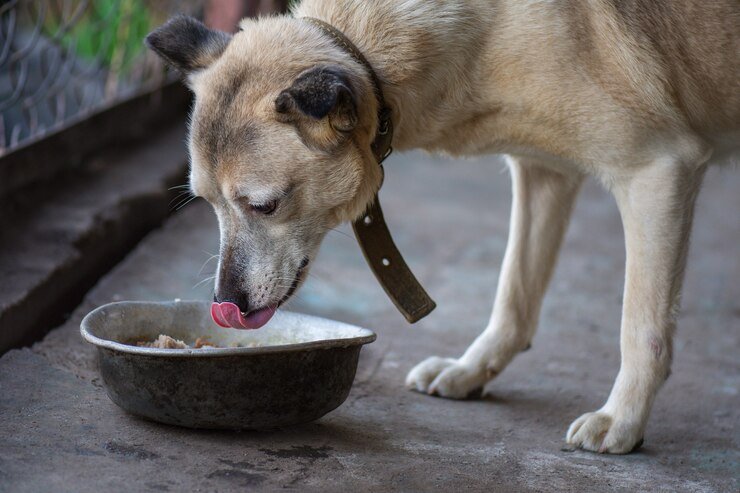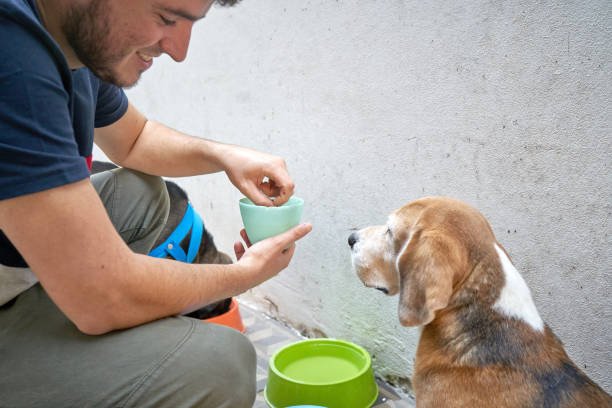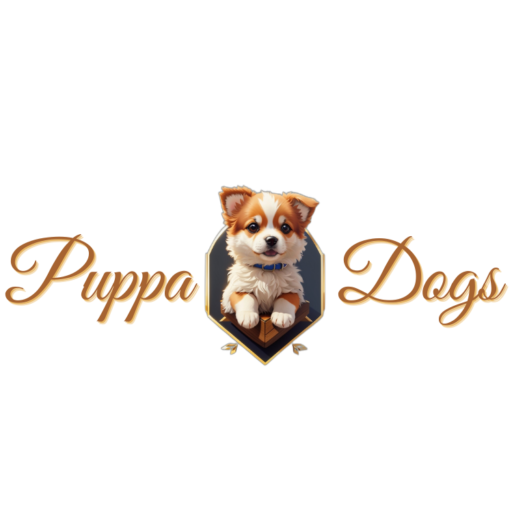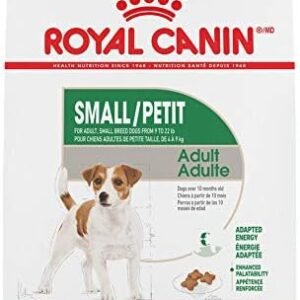Can Dogs Eat Garlic? Have you ever wondered about the culinary curiosities of our canine companions? Dogs, our loyal and loving friends, often seem curious about the food we eat. As responsible pet owners, it’s vital to discern what constitutes a safe and healthy diet for our furry friends. In the realm of human foods, garlic stands out as a versatile and flavorful ingredient, widely celebrated for its myriad of uses in our kitchens.
But here’s a question that piques curiosity: Did you know that garlic is one of the most intriguing foods in the world? It has been hailed for its health benefits, yet it harbors a dark secret for our canine counterparts.

Table of Contents
Understanding Dogs and Their Diet
Our canine friends, with their wagging tails and eager eyes, often share our meals, and it’s only natural to wonder if they can partake in the delights of garlic. As responsible pet owners, we are entrusted with the responsibility of understanding what foods are safe for our dogs and what might pose a threat to their well-being. Dogs, despite their loyalty and love, have different dietary needs and tolerances than humans. This leads us to the pivotal question: can dogs eat garlic?
Navigating the Pros and Cons
As we venture further into this discussion, we will meticulously examine the pros and cons associated with feeding garlic to our canine companions. While garlic possesses a treasure trove of health benefits for humans, the same cannot be said for our four-legged friends. This article will illuminate the potential risks lurking behind the seemingly innocuous cloves of garlic, shedding light on the dangers it might pose to our dogs’ health.
Understanding the Dosage Dilemma
Quantification plays a pivotal role in understanding the impact of any substance, and garlic is no exception. We will explore the fine line between a safe quantity and a hazardous dose when it comes to dogs and garlic consumption. Knowledge in this area is crucial, as even a seemingly small miscalculation can lead to dire consequences for our furry companions.
Dealing with Unfortunate Incidents
Accidents happen, and sometimes our curious canines might find themselves in a situation where they have ingested garlic, intentionally or not. This article will provide valuable insights into what to do if your dog has consumed a part of garlic that is not edible or safe for them. Prompt action is often the key to mitigating potential harm, and knowing the right steps to take can make a significant difference in your pet’s well-being.
In the following sections, we will delve deeper into each aspect, unraveling the complexities of dogs and garlic consumption. It’s not just a matter of feeding our pets; it’s about understanding their unique dietary needs and ensuring their health and happiness. So, let’s embark on this enlightening journey to unravel the truth about dogs and garlic, ensuring the safety and well-being of our cherished companions.
Table: Nutrition Facts of Garlic
Before delving further, let’s break down the nutritional composition of garlic. Understanding the components of this flavorful herb is crucial in comprehending its impact on our furry friends.
| Nutrient | Amount per 100g Quantity |
|---|---|
| Calories | 4.5 |
| Protein | 0.2 g |
| Carbs | 1 g |
| Fiber | 0.1 g |
| Fat | 0 g |
| Vitamin C | 0.9 mg |
| Zinc | 0.04 mg |
| Calcium | 5 mg |
| Iron | 0.2 mg |
| Magnesium | 2 mg |
| Potassium | 36 mg |
| Folate | 1 mcg |
Nutritional Benefits of Garlic for Dogs
Garlic boasts several nutritional elements that can be beneficial for dogs when consumed in moderation. It contains essential nutrients such as Vitamin C, which supports the immune system, and Vitamin B6, vital for brain development and function. Additionally, garlic contains minerals like iron, necessary for the formation of red blood cells, and potassium, crucial for heart health and muscle function. These nutrients, when incorporated sensibly into a dog’s diet, can contribute to their overall well-being.
Drawbacks and Cautionary Notes
However, despite its nutritional benefits, garlic comes with a set of drawbacks that demand careful consideration. One of the primary concerns is the presence of a compound called thiosulfate, which can cause oxidative damage to a dog’s red blood cells, leading to a condition known as hemolytic anemia. This condition can be life-threatening, especially in large quantities.
Moreover, garlic can cause digestive issues in dogs, ranging from upset stomachs to more severe complications like vomiting and diarrhea. Prolonged exposure to garlic, even in small amounts over time, can manifest in symptoms of toxicity. It’s vital to acknowledge that while garlic can offer some nutritional value, it should never replace a dog’s primary diet. Instead, it should be viewed as an occasional treat, administered in small quantities.
In the subsequent sections, we will explore the intricate balance between the potential benefits and risks associated with dogs consuming garlic. By understanding the fine line that separates a safe indulgence from a perilous choice, we can make informed decisions about our pets’ diet. Let’s delve deeper into the complexities of garlic and its impact on our canine companions, ensuring that we prioritize their health and happiness above all else.
How Much Garlic Can a Dog Eat?

In the realm of canine nutrition, the golden rule remains: moderation is key. When it comes to feeding garlic to your dog, this adage holds particular significance. Treats, including garlic, should never constitute a substantial portion of your dog’s daily calorie intake. Instead, they should be regarded as occasional indulgences, a flavorful deviation from their regular diet. Keeping a watchful eye on the portion sizes is paramount to ensuring your dog’s well-being.
To begin this culinary exploration with your canine friend, it’s advisable to start small. Begin by offering a minuscule piece of garlic and observe your dog’s reaction closely. Dogs, like humans, can have varying tastes and tolerances. Some might show enthusiasm for the new flavor, while others might express disinterest. It’s essential to gauge their response before considering further servings. This initial trial serves as a litmus test, allowing you to discern if garlic resonates with your pet’s palate.
Preparing Garlic for Dogs
When preparing garlic for your dog, it’s crucial to follow specific guidelines to minimize risks. Raw garlic, in its natural state, is the most potent and potentially harmful form for dogs. To mitigate potential health hazards, it’s recommended to cook the garlic thoroughly before offering it to your furry companion. Cooking softens the garlic and dilutes its intensity, making it safer for consumption. However, even in its cooked form, moderation should prevail.
Consideration for Size and Breed
The size and breed of your dog play a pivotal role in determining the quantity of garlic they can tolerate. Larger breeds, owing to their higher body mass, might be able to handle slightly larger quantities compared to smaller counterparts. However, this by no means suggests that large dogs are immune to the adverse effects of excessive garlic consumption. Every dog, regardless of its size, should be treated with caution when it comes to introducing new elements into their diet.
Appropriate Serving Sizes Based on Weight
Determining the appropriate serving size of garlic for your dog involves a delicate balance between their weight and the potential risks associated with consumption. As a general guideline, the following table illustrates the recommended serving sizes based on a dog’s weight:
| Dog’s Weight | Maximum Garlic Serving Size (per week) |
|---|---|
| Small (up to 10 lbs) | 1 clove |
| Medium (10-30 lbs) | 2 cloves |
| Large (30-60 lbs) | 3 cloves |
| Extra Large (60+ lbs) | 4 cloves |
It’s crucial to emphasize that these figures are not absolute. Each dog is unique, and their tolerance levels may vary. Factors such as age, overall health, and pre-existing conditions should be taken into account. Regular consultation with a veterinarian is highly advisable to ensure that you are making choices that align with your dog’s specific needs and requirements.
In the subsequent sections, we will delve deeper into the nuances of dog breeds, individual differences, and health considerations, shedding light on the complexities of canine dietary choices. By understanding the intricacies of portion sizes and individual tolerances, we can approach the topic of dogs and garlic with the utmost care and responsibility. Let’s continue our journey into the world of canine nutrition, ensuring the well-being of our beloved pets every step of the way.
What Are the Risks of Feeding Garlic to Dogs?
While the prospect of sharing a delectable treat with our furry friends is undeniably heartwarming, it’s crucial to acknowledge the potential risks involved, especially when it comes to feeding garlic to dogs. Despite its tempting aroma and flavorful taste, garlic poses specific hazards that every responsible pet owner should be aware of.
Addressing Food Allergies in Dogs
Just like humans, dogs can also suffer from food allergies. Introducing new elements into their diet, such as garlic, heightens the risk of triggering allergic reactions. These reactions can manifest in various ways, including skin irritation, itching, and digestive disturbances. It’s essential to recognize that every dog is different, and what suits one might not necessarily agree with another.
Short-Term Signs of Food Intolerance
In the short term, food intolerance to garlic can lead to gastrointestinal distress. Dogs may experience symptoms such as nausea, vomiting, diarrhea, and excessive gas. These signs, while seemingly common, can escalate rapidly, causing discomfort and distress to your beloved pet. It’s crucial to observe your dog closely, especially after introducing garlic into their diet, to identify these signs promptly.
Potential Hazards Related to Garlic Components
Garlic contains certain compounds, such as thiosulfate, that can be highly detrimental to dogs. Thiosulfate can disrupt a dog’s red blood cells, leading to hemolytic anemia, a condition that can be life-threatening if not addressed promptly. This makes garlic ingestion a serious concern, as even a small amount, when ingested consistently over time, can lead to severe health complications.
Specific Issues Caused by Garlic Consumption
Aside from the risk of hemolytic anemia, garlic consumption can result in several other issues. One such concern is the potential for organ damage, especially to the liver, due to the toxic nature of certain compounds found in garlic. Additionally, excessive garlic intake can cause lethargy, loss of appetite, and increased heart rate in dogs. These signs should never be taken lightly; they often indicate a serious underlying problem that demands immediate veterinary attention.
Recognizing Adverse Reactions
It’s imperative for pet owners to be vigilant and watch for signs and symptoms of adverse reactions in dogs after consuming garlic. These signs include but are not limited to:
- Vomiting and Diarrhea: Persistent vomiting or diarrhea, especially if accompanied by blood, is a cause for immediate concern.
- Lethargy: Unusual tiredness or lack of energy can indicate a problem.
- Loss of Appetite: Refusal to eat, even favorite treats, can indicate discomfort or illness.
- Pale Gums: Paleness in the gums can be a sign of anemia, a serious condition often caused by garlic ingestion.
- Difficulty Breathing: Labored breathing or panting excessively can indicate distress.
- Increased Heart Rate: A noticeable increase in heart rate, especially at rest, is a cause for alarm.
Understanding these potential risks and being aware of the signs and symptoms is crucial for ensuring the safety and well-being of your dog. In the next section, we will delve into the steps to take if you suspect your dog has consumed garlic, outlining the necessary actions that can make a significant difference in their recovery process. Let’s continue our journey, armed with knowledge and compassion, to safeguard the health of our cherished pets.
How to Feed Garlic to Your Dog and Make It Enjoyable for Them
Feeding garlic to your dog can be a delicate balancing act between ensuring their safety and providing an enjoyable culinary experience. While it’s crucial to be cautious and mindful of the risks, there are creative and safe ways to incorporate garlic into your pet’s diet, making it not just nutritious but also a flavorful treat.
Different Ways to Feed Garlic
One way to introduce garlic is by offering it as a fresh or frozen treat. Freezing small amounts of garlic can create refreshing bites for your dog, especially during hot weather. Another approach is using garlic as a food topper or mixer. Mixing a small amount of finely chopped or pureed garlic with your dog’s regular food can enhance its flavor, encouraging them to eat more enthusiastically.
Moreover, garlic can be utilized in homemade treats or snacks. By incorporating small quantities of garlic into recipes, you can create delicious and nutritious snacks tailored to your dog’s taste. However, always ensure that the recipes you choose are safe for canine consumption, avoiding harmful ingredients such as chocolate or excessive sugar.
Creative Methods for Enhancing Your Dog’s Food with Garlic

Enhancing your dog’s meals with garlic involves creativity and innovation. One method is making a garlic-infused broth. Simmering garlic cloves in water to create a mild, dog-friendly broth can serve as a delectable addition to their meals. Alternatively, consider mixing garlic with other dog-safe ingredients like plain yogurt or peanut butter to create a spread or filling for dog toys. This not only makes mealtime exciting but also engages your dog mentally, providing enrichment.
Recipes and Ideas for Homemade Treats or Snacks with Garlic
Garlic Peanut Butter Biscuits:
- Ingredients: Whole wheat flour, peanut butter, one clove of minced garlic, water.
- Method: Mix flour, peanut butter, and minced garlic, adding water gradually to create a dough. Roll out and cut into small biscuits. Bake until golden brown.
Frozen Garlic Yogurt Drops:
- Ingredients: Plain yogurt, minced garlic.
- Method: Mix yogurt with minced garlic and spoon small drops onto a baking sheet. Freeze until solid. These refreshing treats are perfect for hot days.
Garlic and Cheese Pupcakes
- Ingredients: Whole wheat flour, shredded cheddar cheese, one clove of minced garlic, eggs, water.
- Method: Combine flour, cheese, and minced garlic. Add eggs and water to form a batter. Pour into cupcake molds and bake. Top with a dollop of yogurt as frosting.
Garlic-Infused Broth:
- Ingredients: Garlic cloves, water.
- Method: Simmer garlic cloves in water until the water absorbs the flavor. Strain and cool. Serve as a warm, soothing broth over your dog’s kibble.
Garlic and Sweet Potato Chews:
- Ingredients: Sweet potatoes, minced garlic.
- Method: Slice sweet potatoes into thin strips. Lightly brush with minced garlic and bake until crispy. These chews are a healthy alternative to store-bought treats.
FAQs About Dogs Eating Garlic: Unraveling the Mysteries
1. Can Dogs Safely Consume Garlic in Any Form?
No, dogs should not consume garlic in any form. While some sources might suggest that cooked or powdered garlic in tiny amounts is safe, the risk of potential harm, such as hemolytic anemia, outweighs any perceived benefits. It’s crucial to avoid all forms of garlic, whether raw, cooked, or powdered, in your dog’s diet.
2. What Is the Safe Dosage of Garlic for Dogs?
There is no universally safe dosage of garlic for dogs. Even small amounts can lead to adverse effects, especially when ingested consistently over time. Dogs vary in size, tolerance, and health status, making it impossible to establish a one-size-fits-all dosage. As a general rule, it’s best to err on the side of caution and avoid garlic entirely.
3. Can Garlic Be Used as a Natural Flea Repellent for Dogs?
While garlic is believed by some to have natural insect-repellent properties, it is not recommended for use in dogs due to its potential health risks. There are safer and more effective flea prevention methods available, such as veterinarian-prescribed topical treatments or oral medications specifically designed for dogs.
4. Are Some Dog Breeds More Tolerant to Garlic Than Others?
No, there is no evidence to suggest that certain dog breeds are more tolerant to garlic than others. All dogs, regardless of their breed, size, or age, are susceptible to the adverse effects of garlic. Every dog’s body processes garlic in a similar way, making them equally vulnerable to its potential dangers.
5. What Are the Signs of Garlic Poisoning in Dogs?
Garlic poisoning in dogs can manifest in various ways. Symptoms may include vomiting, diarrhea, abdominal pain, loss of appetite, lethargy, rapid breathing, pale gums, and jaundice. If you suspect your dog has ingested garlic and is displaying any of these symptoms, it is imperative to seek immediate veterinary care.
6. Can Dogs Develop a Tolerance to Garlic Over Time?
No, dogs do not develop tolerance to garlic with repeated exposure. In fact, consistent ingestion of garlic can lead to the accumulation of harmful compounds in their system, heightening the risk of toxicity. It’s essential to refrain from incorporating garlic into your dog’s diet, regardless of how frequently they are exposed to it.
7. Can Garlic Supplements Be Given to Dogs for Health Benefits?
Garlic supplements are not recommended for dogs. While garlic is touted for its potential health benefits in humans, these advantages do not translate to our canine counterparts. The risks associated with garlic consumption far outweigh any perceived advantages, making it a hazardous choice for supplementation.
8. Is There an Antidote for Garlic Poisoning in Dogs?
There is no specific antidote for garlic poisoning in dogs. Treatment typically involves supportive care to alleviate symptoms and prevent complications. This may include induced vomiting, administration of activated charcoal, intravenous fluids, blood transfusions in severe cases, and other therapies as deemed necessary by a veterinarian.
9. Can Garlic Be Harmful to Nursing or Pregnant Dogs?
Yes, garlic can be particularly harmful to nursing or pregnant dogs. The compounds in garlic can pass into the mother’s milk, affecting both the mother and her puppies. Pregnant and nursing dogs should be kept away from all forms of garlic to ensure the safety of both the mother and her offspring.
10. Are There Any Safe Alternatives to Garlic for Enhancing a Dog’s Diet?
Yes, there are numerous safe and healthy alternatives to enhance a dog’s diet. Natural additions such as carrots, blueberries, pumpkin, and lean proteins like boiled chicken or turkey can be incorporated into their meals to add flavor and nutrition. Additionally, commercial dog treats and toys designed to promote dental health and mental stimulation offer a safe way to indulge your pet.
Conclusion
In summary, understanding the complexities of feeding garlic to dogs is vital for every pet owner. While it’s tempting to share our favorite foods with our furry friends, garlic should be approached with extreme caution. As demonstrated, dogs can consume garlic in minuscule amounts as an occasional treat, but the potential risks loom large. Excessive or improper intake can lead to severe health complications, including life-threatening conditions like hemolytic anemia.



















